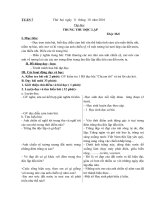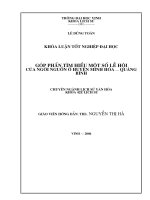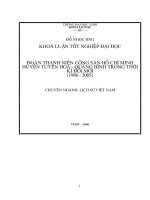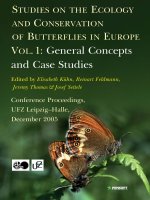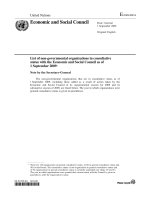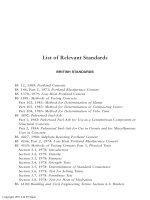Species List of Butterflies (Lepidoptera: rhopalocera) in Minh Hoa, Quang Binh
Bạn đang xem bản rút gọn của tài liệu. Xem và tải ngay bản đầy đủ của tài liệu tại đây (118.23 KB, 11 trang )
<span class='text_page_counter'>(1)</span><div class='page_container' data-page=1>
47
Species List of Butterflies (Lepidoptera: rhopalocera)
in Minh Hoa, Quang Binh
Vu Van Lien*
<i>Vietnam National Museum of Nature, Vietnam Academy of Science and Technology, </i>
<i>18 Hoang Quoc Viet, Cau Giay, Hanoi, Vietnam </i>
Received 19 November 2012
<i>Revised 13 January 2015; Accepted 28 June 2016 </i>
<b>Abstract: Study on butterflies of Minh Hoa was carried out in 2 communes of Thuong Hoa and </b>
Hoa Son, Minh Hoa district, Quang Binh province. The study was conducted in different habitats,
from shrub and grass, secondary forest, and primary forest at the low land to the highland of the
area in April and May 1999. The total 259 butterfly species was recorded; one conservation
<i>species is Troides aeacus; two new species to science described from the area are Celaenorrhinus </i>
<i>incestus and C. kuznetsovi. The rare species with 1-3 individuals are 86 species consiting of 33.2% </i>
total species; the most abundant species with more than 100 individuals are 10 species consisting
of 3.9% total species. The butterfly fauna of Minh Hoa is characterized by the fauna of
India-Malaysia region (86.8% of species of Minh Hoa distributed in this region). The species
composition of Minh Hoa butterflies is close to the species composition of butterflies in Cat Ba,
Tam Dao, and Ba Be in the North of Vietnam.
<i><b>Keywords: </b></i><b>Butterflies, Distribution range, Forest, Similarity. </b>
<b>1. Introduction</b>
<sub>∗</sub>
<sub>∗</sub>
<sub>∗</sub>
<sub>∗</sub>
Phong Nha - Ke Bang National Park, a huge
park of Vietnam, is located in the middle of the
Truong Son mountain range in two districts of
Bo Trach and Minh Hoa of Quang Binh
province, bordering with Nature Reserve Hin
Namno of Laos in the west. Core area of the
Park is 85,754 ha and 195,400 ha of buffer zone
including habitats on land and water, primary
and secondary forests, natural regeneration of
forests, tropical forests and savanna and large
cave system well known in the world.
_______
∗<sub>ĐT.: 84-904145453 </sub>
Email:
</div>
<span class='text_page_counter'>(2)</span><div class='page_container' data-page=2>
<b>2. Materials and methods </b>
Research was carried out in the communes
of Hoa Son and Thuong Hoa, Minh Hoa
district, Quang Binh province in April and May
1999. The study area is located in the Phong
Nha - Ke Bang National Park. Habitats include
primary forest, secondary forest, grassland and
shrub of low to high altitude of 1000 m above
sea level.
Butterfly specimens were collected by
insect nets at different habitats. In additional,
the presence and relative abundance of
butterflies were also observed and recorded to
assess the presence and abundance of butterflies
of the area. Butterflies specimens were dried
and put in envelopes, some of them were
mounted and kept in boxes.
Nomenclature and identification of butterfly
species is followed Chou [8], Devyatkin &
Monastyrskii [1]; D'Abrera [9], Monastyrskii &
Devyatkin [3]; Osada et al. (1999) [10].
Information on the geographical distribution
range of each species was based on literature on
geographical distribution of butterflies of
Vietnam and in the region [1-4, 7-11]. The
geographical distribution range (R) of species
was categorized on a scale from 1 to 5 (smallest
to largest): (R1) Endemic: East Himalayas,
South China, North Indochina; (R2) Southeast
Asian mainland from northeastern India to
Malaysia and Sumatra; (R3) Indo-Malayan
region; (R4) Indo-Malayan and Australasian
regions; and Palaearctic, extending into the
Indo-Malayan region; and (R5) Old World
tropics, Holarctic, or Cosmopolitan.
The
similarity
of butterfly species
composition
of Minh Hoa
with other areas
of
Vietnam (Ba Be, Tam Dao, Cat Ba,
Minh Hoa, Hon Ba, Ngoc Linh, Phu Quoc)
was analyzed with Cluster Analysis using
Similarity Tree software
[
12].
<b>3. Result and discussion </b>
Total 259 species of butterflies were
identified and recorded during the survey period
of April and May 1999 (Table 1). A
conservation species, included in Decree 32 of
the Government of the Socialist Republic of
<i>Vietnam, is Troides aeacus (Papilionidae </i>
family) [13]. The species is rare, with only 2
individuals recorded. Two new species for
<i>science in Minh Hoa are Celaenorrhinus </i>
<i>incestus </i>
and
<i>Celaenorrhinus </i>
<i>kuznetsovi</i>
(Hesperiidae) [1].
Table 1. Species, abundance and geographical distribution range of butterflies of Minh Hoa, Quang Binh
province (April and May 1999)
No. Family, species Abundance
Distribution
range (R)
<b>Family Papilionidae </b>
1 <i>Troides aeacus</i> (C. Felder & R. Felder, 1860) R 2
2 <i>Chilasa slateri</i> (Hewitson, 1857) S 3
3 <i>Chilasa paradoxa telearchus</i> (Hewitson, 1852) S 4
4 <i>Papilio domeleus</i> Linnaeus, 1758 U 1
5 <i>Papilio castor mahadeva Moore, 1879 </i> C 4
6 <i>Papilio helenus (Linnaeus, 1758) </i> C 2
7 <i>Papilio nephelus chaon</i> Westwood, 1845 C 2
8 <i>Papilio polytes romulus</i> Cramer, 1775 C 3
9 <i>Papilio memnon agenor</i> Linnaeus, 1758 S 2
10 <i>Papilio alcmenor</i> Felder &Felder, 1865 C 2
</div>
<span class='text_page_counter'>(3)</span><div class='page_container' data-page=3>
12 <i>Papilio bianor</i> Cramer, 1777 S 2
13 <i>Papilio paris</i> Linnaeus, 1758 C 3
14 <i>Graphium agetes</i> (Westwood, 1843) S 1
15 <i>Graphium aristeus</i> (Stoll, 1780) C 4
16 <i>Graphium antiphates</i> (Cramer, 1775) C 2
17 <i>Graphium macareus</i> (Godart, 1819) C 3
18 <i>Graphium xenocles</i> (Doubleday, 1842) C 2
19 <i>Graphium megarus</i> (Westwood, 1844) U 2
20 <i>Graphium sarpedon</i> (Linnaeus, 1758) C 4
21 <i>Graphium doson</i> (C. Felder & R. Felder, 1864) N 2
22 <i>Graphium eurypylus</i> (Linnaeus, 1758) C 4
23 <i>Graphium chironides</i> (Honrath, 1884) U 2
24 <i>Graphium agamemnon</i> (Linnaeus, 1758) U 4
25 <i>Lamproptera curius</i> (Fabricius, 1787) N 3
26 <i>Lampropter meges virescens</i> (Butler, [1870]) N 3
<b>The family Pieridae </b>
27 <i>Leptosia nina</i> (Fabricius, 1793) S 3
28 <i>Prioneris thestylis</i> (Doubleday, 1842) C 2
29 <i>Prioneris philonome</i> (Boisduval, 1836) U 2
30 <i>Pieris rapae</i> (Linnaeus, 1758) S 5
31 <i>Pieris canidia</i> (Linnaeus, 1768) U 5
32 <i>Cepora nerissa</i> (Fabricius, 1775) U 3
33 <i>Cepora nadina</i> (Lucus, 1852) C 2
34 <i>Appias lyncida</i> (Cramer, 1777) N 3
35 <i>Appias libythea olferna</i> Swinhoe, 1890 R 3
36 <i>Appias nero</i> (Fabricius, 1793) R 2
37 <i>Appias albina</i> (Boisduval, 1836) N 3
38 <i>Appias indra</i> (Moore, 1857) N 2
39 <i>Appias lalage</i> (Doubleday, 1842) S 2
40 <i>Appias lalassis</i> Grose-Smith, 1887 R 1
41 <i>Ixias pyrene</i> (Linnaeus, 1764) C 3
42 <i>Hobomoia glaucippe</i> (Linnaeus, 1758) C 3
43 <i>Dercas verhuelli</i> (van der Hoeven, 1839) U 2
44 <i>Dercas lycorias</i> (Doubleday, 1842) R 2
45 <i>Catopsilia pomona</i> (Fabricius, 1775) C 4
46 <i>Catopsilia scylla cornelia (Fabricius, 1787) </i> S 4
47 <i>Eurema hecabe</i> (Linnaeus, 1758) C 4
48 <i>Eurema blanda</i> (Boisduval, 1836) U 2
49 <i>Eurema andersonii </i>(Moore, 1886) C 2
50 <i>Eurema novapallida</i> Yata, 1992 R 1
51 <i>Gandaca harina</i> (Horsfield, 1829) C 4
<b>Family Danaidae </b>
52 <i>Danaus chrysippus</i> (Linnaeus, 1758) S 5
53 <i>Danaus genutia</i> (Cramer, 1779) C 4
54 <i>Tirumala septentrionis</i> (Butler, 1874) U 3
55 <i>Parantica aglea</i> (Stoll, 1782) C 2
</div>
<span class='text_page_counter'>(4)</span><div class='page_container' data-page=4>
57 <i>Euploea modesta</i> Butler, 1866 R 1
58 <i>Euploea camaralzeman</i> Butler, 1866 U 1
59 <i>Euploea core</i> (Cramer, 1780) R 3
60 <i>Euploea algea limborgii</i> Moore, [1819] C 3
61 <i>Euploea sylvester</i> (Fabricius, 1793) U 2
62 <i>Euploea mulciber</i> (Cramer, 1777) N 3
63 <i>Euploea tulliolus</i> (Fabricius, 1793) U 3
64 <i>Euploea klugii erichsonii Felder, [1865] </i> R 2
65 <i>Euploea eunice</i> (Godart, 1819) C 1
66 <i>Euploea radamanthus</i> (Fabricius, 1793) C 2
<b>Family Satyridae </b>
67 <i>Melanitis leda</i> (Linnaeus, 1758) C 4
68 <i>Melanitis phedima</i> (Cramer, 1780) U 3
69 <i>Elymnias patna</i> (Westwood, 1851) S 2
70 <i>Elymnias hypermnestra</i> (Linnaeus, 1763) S 3
71 <i>Elymnias casiphone saueri Distant, 1882 </i> S 2
72 <i>Penthema darlisa mimetica</i> Lathy, 1900 S 1
73 <i>Lethe verma</i> (Kollar, 1844) C 2
74 <i>Lethe confusa</i> Aurivillius, 1897 C 2
75 <i>Lethe mekara</i> (Moore, 1858) S 2
76 <i>Coelites nothis</i> Westwood, 1850 R 2
77 <i>Orsotriaena medus</i> (Fabricius, 1775) R 4
78 <i>Mycalesis inopia</i> Fruhstorfer, 1908 S 1
79 <i>Mycalesis deficiens</i> Fruhstorfer, 1908 R 1
80 <i>Mycalesis siamica</i> Riley & Godfrey R 1
81 <i>Mycalesis intermedia</i> (Moore, 1892) C 1
82 <i>Mycalesis annamitica</i> Fruhstorfer, 1906 C 1
83 <i>Mycalesis mystes</i> de Niceville U 1
84 <i>Ragadia crisilda</i> Hewitson, 1862 R 2
85 <i>Ypthima baldus</i> (Fabricius, 1775) C 3
86 <i>Ypthima huebneri</i> Kirby, 1871 C 2
87 <i>Ypthima imitans</i> Elwes & Edwards, 1893 U 2
<b>Family Amathusiidae </b>
88 <i>Faunis canens</i> (Hubner, 1826) C 2
89 <i>Faunis eumeus</i> (Drury, 1773) C 2
90 <i>Aemona amathusia </i>(Hewitson, 1867) U 1
91 <i>Stichphthalma fruhstorferi</i> Rober, 1903 S 1
92 <i>Thaumantis diores</i> Doubleday, 1845 R 2
93 <i>Thauria lathyi</i> (Fruhstorfer, 1902) U 1
<b>Family Acraeidae </b>
94 <i>Acraea issoria</i> (Hubner, 1819) U 3
95 <i>Acraea violae</i> (Fabricius, 1793) R 3
<b>Family Nymphalidae </b>
96 <i>Cethosia biblis</i> (Drury, 1773) S 3
97 <i>Cethosia cyane </i>(Drury, 1773)
98 <i>Vindula erota</i> (Fabricius, 1793) C 3
</div>
<span class='text_page_counter'>(5)</span><div class='page_container' data-page=5>
100 <i>Vagrans egista</i> (Cramer, 1780) C 3
101 <i>Cupha erymanthis</i> (Drury, 1773) C 3
102 <i>Phalanta phalanta</i> (Drury, 1773) R 3
103 <i>Symbrenthia lilaea</i> (Hewitson, 1864) C 2
104 <i>Junonia iphita</i> (Cramer, 1779) R 2
105 <i>Junonia atlites</i> (Linnaeus, 1763) C 2
106 <i>Junonia almana</i> (Linnaeus, 1758) C 3
107 <i>Junonia lemonias</i> (Linnaeus, 1758) R 4
108 <i>Junonia hierta</i> (Fabricius, 1798) S 3
109 <i>Hypolimnas bolina</i> (Linnaeus, 1764) U 4
110 <i>Deleschallia bisaltide</i> (Cramer, 1777) U 3
111 <i>Cyrestis themire</i> Honrath, 1884 N 1
112 <i>Cyresthis cocles</i> (Fabricius, 1787) R 2
113 <i>Cyrestis thyodamas</i> Boisduval, 1836 C 3
114 <i>Chersonesia risa</i> (Doubleday, 1848) C 2
115 <i>Neptis clinia</i> (Moore, 1872) C 3
116 <i>Neptis sappho astola</i> Moore, 1872 S 5
117 <i>Neptis hylas</i> (Linnaeus, 1758) C 4
118 <i>Neptis soma</i> Moore, 1858 S 2
119 <i>Neptis nata</i> Moore, 1858 C 3
120 <i>Phaedyma columella</i> (Cramer, 1780) U 4
121 <i>Pantoporia sandaka davidsoni</i> Eliot, 1969 R 3
122 <i>Lassipa heliodore</i> (Fabricius, 1787) S 2
123 <i>Lassipa monata</i> (Weyenbergh, 1874) S 1
124 <i>Athyma selenophora</i> (Kollar, 1844) R 3
125 <i>Athyma cama</i> Moore, 1858 S 2
126 <i>Athyma nefte</i> (Cramer, 1780) S 3
127 <i>Athyma ranga</i> Moore, 1857 S 3
128 <i>Cynitia cocytus</i> (Fabricius, 1787) S 2
129 <i>Cynitia telchinia</i> (Menetries) S 2
130 <i>Euthalia monina</i> (Moore, 1859) S 3
131 <i>Stibochiona nicea</i> (Gray, 1846) R 2
132 <i>Pseudergolis wedah</i> (Kollar, 1844) R 2
133 <i>Lexias dirtea</i> (Fabricius, 1793) S 3
134 <i>Lexias cyanipardus</i> (Butler, 1869) S 2
135 <i>Rohana tonkiniana</i> Fruhstorfer, 1906 S 1
136 <i>Eulaceura osteria</i> (Westwood, 1850) S 1
137 <i>Herona marathus</i> (Doubleday, 1848) S 2
138 <i>Euripus nyctelius</i> (Doubleday, 1845) U 3
139 <i>Hestina nama</i> (Doubleday, 1844) U 2
140 <i>Polyura nepenthes</i> (Grose-Smith, 1883) S 1
141 <i>Charaxes bernardus</i> (Fabricius, 1793) S 3
142 <i>Charaxes aristogiton</i> Felder, 1867 R 2
143 <i>Charaxes marmax</i> Westwood, 1848 S 2
144 <i>Charaxes kahruba</i> (Moore, 1895) S 2
<b>Family Libytheidae </b>
</div>
<span class='text_page_counter'>(6)</span><div class='page_container' data-page=6>
146 <i>Libythea geoffroyi alompra Moore, [1901] </i> C 2
<b>Family Riodinidae </b>
147 <i>Zemeros flegyas</i> (Cramer, 1843) C 2
148 <i>Abisra fylla</i> (Westwood, 1851) C 2
149 <i>Abisra echerius</i> (Stoll, 1790) S 2
150 <i>Abisara neophron</i> (Hewitson, 1861) R 2
151 <i>Paralaxita dora</i> (Fruhstorfer, 1904) R 1
152 <i>Stiboges nymphidia</i> (Butler, 1876) U 2
<b>Family Lycaenidae </b>
153 <i>Miletus ancon</i> (Doherty, 1889) S 1
154 <i>Allotinus substrigosus</i> (Moore, 1884) S 2
155 <i>Curetis bulis</i> Westwood, 1851 U 2
156 <i>Caleta elna</i> (Hewitson, 1876) S 3
157 <i>Caleta roxus</i> (Godart, 1823) R 3
158 <i>Pithcops fulgens</i> Doherty, 1889 N 2
159 <i>Megisba malaya</i> (Horsfield, 1828) R 3
160 <i>Acytolepis puspa</i> (Horsfield, 1828) U 3
161 <i>Udara dilecta</i> (Moore, 1879) U 3
162 <i>Udara placidula </i>(Druce, 1895) C 2
163 <i>Celastrina lavendularis </i>(Moore, 1877) C 3
164 <i>Neopithecops zalmora</i> (Butler) C 3
165 <i>Zizeeria maha</i> (Kollar, 1844) S 2
166 <i>Catochrysops panormus</i> (Felder) U 4
167 <i>Jamides bochus</i> (Stoll, 1782) U 4
168 <i>Jamides celeno</i> (Cramer, 1775) R 4
169 <i>Jamides elpis </i>(Godart, [1824]) R 1
170 <i>Jamides alecto</i> (Felder, 1860) U 3
171 <i>Nacaduba kurava</i> (Moore, 1857) C 3
172 <i>Nacaduba beroe gythion</i> Fruhstorfer, 1916 U 4
173 <i>Nacaduba berenice</i> (Herrich-Schaffer) U 3
174 <i>Nacaduba hermus</i> (Felder, 1860) C 4
175 <i>Prosotas nora</i> (Waterhouse & Lyell, 1914) U 3
176 <i>Prosotas pia marginata Tite, 1963 </i> U 4
177 <i>Petrelaea dana</i> (de Niceville) U 3
178 <i>Anthene emolus</i> (Godart, [1824]) R 4
179 <i>Heliophorus kohimensis delacouri Eliot, 1963 </i> N 2
180 <i>Arhopala khamti</i> Doherty, 1891 S 2
181 <i>Arhopala ammonides</i> (Doherty, 1891) S 2
182 <i>Arhopala aida</i> de Niceville, 1889 S 2
183 <i>Thaduka multicaudata</i> Moore, [1879] S 2
184 <i>Mahathala ameria burmana</i> (Talbot, 1936) S 2
185 <i>Surendra quercetorum</i> (Moore, [1858]) S 3
186 <i>Amblypodia anita</i> Hewitson, 1862 S 3
187 <i>Spindasis syama</i> (Horsfield, 1829) R 2
188 <i>Spindasis lohita</i> (Horsfield, 1829) S 2
189 <i>Yasoda tripunctata</i> (Hewitson, 1863) C 2
</div>
<span class='text_page_counter'>(7)</span><div class='page_container' data-page=7>
191 <i>Tajuria maculata</i> (Hewitson, [1865]) S 2
192 <i>Zeltus amasa</i> (Hewitson, 1865) U 2
193 <i>Sinthusa nasaka amba</i> (Kirby, 1878) C 2
194 <i>Rapala manea schistacea</i> (Moore, 1879) S 2
<b>Family Hesperiidae </b>
195 <i>Bibasis jaina margana</i> (Fruhstorfer, 1911) S 3
196 <i>Hasora chromus chromus</i> (Cramer, [1780]) C 4
197 <i>Hasora taminatus bhavara</i> Fruhstorfer, 1911 U 2
198 <i>Hasora malayana</i> (C. & R. Felder, 1860) U 1
199 <i>Hasora vitta vitta </i>(Butler, 1870) C 3
200 <i>Badamia exclamationis</i> (Fabricius, 1775) C 4
201 <i>Choaspes stigmatus stigmatus</i> Evans, 1932 S 2
202 <i>Celaenorrhinus incestus</i> Devyatkin, 2000 U 2
203 <i>Celaenorrhinus kuznetsovi</i> Devyatkin, 2000 S 1
204 <i>Celaenorrhinus putra sanda </i>Evans, 1941 C 2
205 <i>Celaenorrhinus nigricans nigricans</i> (de Nicecille, 1885) S 2
206 <i>Celaenorrhinus vietnamicus</i> Devyatkin, 1998 C 2
207 <i>Darpa pteria dealbata</i> (Distant, 1886) S 3
208 <i>Darpa striata minta </i>Evans, 1949 S 2
209 <i>Pseudocoladenia dan fabia</i> Evans, 1949 U 2
210 <i>Coladenia agni sundae </i>de Jong, 1992 R 2
211 <i>Seseria </i>sp. S 2
212 <i>Tagides menaka menaka</i> (Moore, [1866]) U 3
213 <i>Tagiades litigiosa litigiosa</i> Moschler, 1878 U 3
214 <i>Abraximorpha davidii elfina</i> Evans, 1949 U 2
215 <i>Mooreana trichoneuma pralaya</i> (Moore, [1866]) U 2
216 <i>Odontoptilum angulata angulata</i> (Felder, 1862) S 3
217 <i>Pintara pinwilli pinwilli</i> (Butler, 1877) S 1
218 <i>Astictopterus jama olivascens</i> Moore, 1878 C 2
219 <i>Ochus subvittatus subvittatus</i> (Moore, 1878) R 2
220 <i>Arnetta atkinsoni</i> (Moore, 1878) C 2
221 <i>Halpe porus</i> (Mabile, [1877]) S 2
222 <i>Halpe pelethronix pagaia</i> Evans, 1932 S 1
223 <i>Pithauria murdava</i> (Moore, [1866]) S 2
224 <i>Iambrix salsala salsala</i> (Moore, [1866]) U 3
225 <i>Koruthaialos rubecula hector</i> Watson, 1893 C 3
226 <i>Koruthaialos sindu sindu</i> (C.&R. Felder, 1860) U 3
227 <i>Koruthaialos butleri</i> de Niceville, [1884] S 2
228 <i>Stimula swinhoei swinhoei</i> (Elwes & Edward, 1897s) S 2
229 <i>Ancistroides nigrita diocles </i>(Moore, [1866]) S 3
230 <i>Notocrypta clava theba</i> Evans, 1949 S 1
231 <i>Notocrypta curvifascia curvifascia</i> (C.&R.Felder, 1862) R 3
232 <i>Notocrypta feisthamelii alysos</i> (Moore, [1866]) U 3
233 <i>Notocrypta paralysos asawa Fruhstorfer, 1911 </i> S 3
234 <i>Scobura cephaloides kinka</i> Evans, 1949 R 2
235 <i>Suastus minuta aditia</i> Evans, 1943 R 3
</div>
<span class='text_page_counter'>(8)</span><div class='page_container' data-page=8>
237 <i>Zographetus satwa</i> (de Niceville, [1884]) R 2
238 <i>Zographetus doxus</i> Eliot or ogygia (Hewitson, [1866]) R 1
239 <i>Hyarotis adrastus praba</i> (Moore, [1866]) S 3
240 <i>Isma bononia idyalis</i> de Niceville, 1897 S 1
241 <i>Pyroneura margherita miriam</i> (Evans, 1941) R 2
242 <i>Lotongus sarala chinensis </i>Evans, 1932 S 2
243 <i>Erionota torus</i> Evans, 1941 S 2
244 <i>Erionota thrax thrax</i> (Linnaeus, 1767) S 3
245 <i>Pirdana hyela rudolphii</i> Elwes & de Niceville, [1887] S 3
246 <i>Potanthus trachala tytleri</i> (Evans, 1941) R 2
247 <i>Potanthus mingo ajax</i> (Evans, 1932) U 3
248 <i>Potanthus pava pava</i> (Fruhstorfer, 1911) S 3
249 <i>Potanthus ganda ganda</i> (Fruhstorfer, 1911) R 2
250 <i>Potanthus pallida</i> (Evans, 1932) U 3
251 <i>Telicopta besta</i> Evans, 1949 S 2
252 <i>Telicopta ohara jix</i> Evans, 1949 R 4
253 <i>Parnara bada bada</i> (Moore, 1878) R 4
254 <i>Borbo cinnara</i> (Wallace, 1866) S 4
255 <i>Pelopidas agna agna</i> (Moore, [1866]) C 4
256 <i>Pelopidas assamensis</i> (de Niceville, 1882) S 2
257 <i>Polytremis lubricans lubricans</i> (Herrich-Schaffer, 1869) C 2
258 <i>Baoris penicillata chapmani</i> Evans, 1937 S 2
259 <i>Caltoris cormasa</i> (Hewitson, 1876) S 3
<i> Note</i>: N: more than 100 individuals; C: more than 50 - 100 individuals; U: more than10 - 50 individuals; R: 4 - 10
individuals; S: 1 - 3 individuals.
Geographical distribution range: (R1) endemic to Indochina region including Eastern Himalayas, South China, North
Indochina; (R2) Southeast Asia mainland from northeastern India to Malaysia and Sumatra; (R3) The India, China to
Malaysia; (R4) India - Malaysia and Australia region - Asia, and Palaearctic, extending to the India – Malaysia region; and
(R5) Old World tropics, Holarctic, or Cosmopolitan.
Species with least individuals, from 1 to 3
individuals, are 86 species, accounting for
33.2% total species. Species with 4 to 10
individuals are 45 species (17.4%). The most
species are single and rare (131 species,
accounting for 50.6% total species) (Table 2).
Species with the most individuals more than
100 are 10 species (3.9%). This result is
entirely consistent with results on butterfly
studies tropical regions that the majority of
species have low individual number (rare
species) [5, 14]. Temperate regions, where have
low species diversity, but individuals of each
species are high, whereas, in the tropics there
are many species, but the individual number of
each species is low [15]. It can be seen as an
ecological rules on the relationship between
species diversity and abundance of species, the
diversity of species increases, the abundance of
each species decreases and vice versa.
Number of species by
geographical
distribution range is presented in Table 3. The
most species number is in the Southeast Asia
mainland (R2) with 112 species (representing
43.24% total species); followed by
India-Malayan region (R3) with 81 species (31.27%).
There are 4 species (1.54%) in Old World
tropics, Holarctic, or Cosmopolitan. Species
with the smallest geographical distribution
range species (Indochina) (R1) are 32 species
(12.36%).
</div>
<span class='text_page_counter'>(9)</span><div class='page_container' data-page=9>
Indo-Malayan region) is 225 species (accounting for
86.8% total species). Thus, Minh Hoa butterfly
fauna is characterized for the butterfly fauna of
India - Malaysia.
Table 2. Number of butterfly species and their percentage by abundance levels
No. Abundance Number of
species
Percentage %
1 1-3 individuals (S) 86 33.2
2 4-10 individuals (R) 45 17.4
3 More than 10-50 individuals (U) 50 19.3
4 More than 50-100 individuals (C) 68 26.2
5 More than 100 individuals (N) 10 3.9
Total 259 100.0
Table 3. Number of species by geographical distribution range
Geographical distribution range (smalllest to widest)
Species number
and percentage R1 R2 R3 R4 R5
Species number 32 112 81 30 4
Percentage % 12.36 43.24 31.27 11.58 1.54
Note: The geographical distribution range as in the Table 1.
The similarity of species composition of
Minh
Hoa
is
compared
with
species
compositions of National Parks and Nature
Reserves from North to South Vietnam (Figure
1). Data on species composition are taken from
statistic work (Vu Van Lien, 2010) [6]. The
species composition of Minh Hoa (MH) is
rather similar to the species composition of Cat
Ba (CB) with 51%, 52% with Tam Dao (TD),
and 58% with Ba (BB). The butterfly species
composition of Minh Hoa is quite different
from the species composition of Ngoc Linh and
Hon Ba (central mountain area) with 45%,
lower with the Hoang Lien (HL) 36% and Van
ban 37 %, and Phu Quoc (PQ) 36%.
The result indicates that the species
composition of Minh Hoa is rather similar to
the species composition Ba Be, Tam Dao, and
Cat Ba. The reason is because this area is not
far from each other geographically. In
additional, these areas are not much different in
altitudes [6].
Phu Quoc
Hoang Lien
Hon Ba
Ngoc Linh
Minh Hoa
Cat Ba
Tam Dao
Ba Be
20 40 60 80 100
</div>
<span class='text_page_counter'>(10)</span><div class='page_container' data-page=10>
<b>4. Conclution </b>
Total 259 butterfly species are recorded in
Minh Hoa, Quang Binh in April and May 1999.
This is the first species list of butterflies in the
<i>area. One conservation species is Troides </i>
<i>aeacus</i>
; two new species to science described
<i>from Minh Hoa are Celaenorrhinus incestus </i>
and
<i>Celaenorrhinus </i>
<i>kuznetsovi</i>
.
Butterfly
species of Quang Binh is close to butterfly
composition species of North Vietnam (Cat Ba,
Ba Be, and Tam Dao National Parks). Butterfly
fauna of Minh Hoas is characterized by
India-Malaysia with 86.8% of total species distributed
in this region.
<b>Acknowledgment </b>
This paper is for memory of Alexey
Devyatkin who greatly contributed to study on
butterflies of Vietnam.
<b>References </b>
[1] A. L. Monastyrskii, Hesperiidae from Vietnam,
12. A further contribution to the Hesperiidae
fauna of North and Central Vietnam. Atalanta 33
(2002) 137.
[2] J. Hill, A.L. Monastyrskii, Butterfly fauna of
protected areas in North and Central Vietnam:
collections 1994-1997 (Lepidoptera,
Rhopalocera), Atalanta 29 (1999) 185.
[3] A.L. Monastyrskii, A.L.Devyatkin, A system list
of butterflies of Vietnam, Thong Nhat Publishing
House (2003).
[4] K. Spitzer, J. Jaros, J. Havelka, J. Leps, Effect of
small-scale disturbance on butterfly communities
of an Indochina montane rainforest. Biological
Conservation 80 (1997) 9.
[5] V. V.Lien, Biodiversity of butterflies
(Lepidoptera: Rhopalocera) and ecological
indicator role of some butterfly species in Tam
Dao National Park, Vinh Phuc, PhD thesis,
Institute of Ecology and Biological Resources,
Hanoi, Vietnam (2008) (in Vietnamese).
<b>[6] V. V. Lien, Diversity of butterflies of Vietnam, </b>
The Proceeding on 35th Foundation Anniversary
of Vietnam Academy of Science and Technology
(1975-2010), The Natural Science and
Technology Publishing House, Hanoi (2010) 22
(in Vietnamese).
[7] V. V.Lien, Diversity and similarity of butterfly
communtities in five different habitat types at
Tam Dao National Park, Vietnam, Journal of
Zoology 27 (2009) 15
[8] L. Chou, Monographia Rhopalocerum
Sinensium.,Vol. 1-2, Henan Science and
Technology Press, Henan, China (1994).
[9] D’ Abrera, Butterflies of the Oriental Region, Vol.
1-3, Hill House, Melbourne, 1982-1986.//9
[10] S. Osada, Y. Uemura, J. Uehara, An illustrated
checklist of the butterflies of Laos P.D.R. Tokyo,
Japan (1999).
[11] . Access December 2013.
[12] Primer-E Ltd.,Primer 5 for Windows, Version
5.2.4 (2001).
[13] Government of Social Republic of Vietnam, 2006.
Decree No. 32/2006/ND-CP dated 30 March 2006
about management of rare and precious
endangered forest plant and animal (in
Vietnamese).
<b>[14] P.W. Price, Insect Ecology, John Wiley, Sons, </b>
Inc. (1975).
</div>
<span class='text_page_counter'>(11)</span><div class='page_container' data-page=11>
<b>Thành phần loài bướm (Lepidoptera: Rhopolocrea) </b>
ở Minh Hóa, Quảng Bình
Vũ Văn Liên
<i>Bảo tàng Thiên nhiên Việt Nam, VAST, </i>
<i>18 Hoàng Quốc Việt, Cầu Giấy, Hà Nội, Việt Nam </i>
<b>Tóm tắt: Nghiên cứu thành phần lồi bướm Minh Hóa được tiến hành ở 2 xã Thượng Hóa và Hóa </b>
Sơn, huyện Minh Hóa, tỉnh Quảng Bình trong tháng 4 và tháng 5 năm 1999. Nghiên cứu ở các loại
sinh cảnh khác nhau: từ cây bụi, trảng cỏ, rừng thứ sinh khu vực thấp đến rừng nguyên sinh khu vực
<i>cao. Tổng số 259 lồi bướm đã được ghi nhận; trong đó, một lồi có giá trị bảo tồn là Troides aeacus, </i>
<i>hai lồi mới cho khoa học được mơ tả từ Minh Hóa là Celaenorrhinus incestus và C. kuznetsovi. Lồi </i>
hiếm gặp có số cá thể từ 1-3 là 86 loài chiếm 33,2% tổng số lồi, lồi phong phú nhất có số cá thể trên
100 là 10 loài chiếm 3,9% số loài bướm ghi nhận ở khu vực nghiên cứu. Khu hệ bướm Minh Hóa
mang tính chất của khu hệ Ấn Độ - Mã Lai với 86,8% tổng số loài phân bố ở khu vực này. Thành phần
loài bướm Minh Hóa khá gần gũi với thành phần lồi bướm ở Cát Bà, Ba Bể và Tam Đảo ở miền Bắc
Việt Nam.
</div>
<!--links-->
